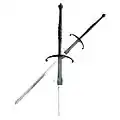Flame-bladed sword
A flame-bladed sword or wave-bladed sword has a characteristically undulating style of blade. The wave in the blade is often considered to contribute a flame-like quality to the appearance of a sword. The dents on the blade can appear parallel or in a zig-zag manner. The two most common flame-bladed swords are rapiers or Zweihänders. A flame-bladed sword was not exclusive to a certain country or region. The style of blade can be found on swords from modern-day Germany, France, Spain,[1] and Switzerland.[2]

Flambard, Flammard, and Flammenschwert
The two-handed flame-bladed sword is referred to by the German Flammenschwert (literally "flame-sword"). These swords are very similar to the two-handed sword or Zweihänder, the only difference being the blade. The design of the blade is decorative along with being functional by causing unpleasant vibrations while parrying. Still, the undulating blade is no more effective at cutting than a straight one.[3] An advantage over swords with a straight blade is that a waved blade could better distribute the force of impact and thus was less likely to break.[4] It could also threaten the opponent in a duel and may have discouraged them from grabbing the blade.[1] Like other Zweihänders, they were used during the 16th century by the Landsknechts (well-trained and experienced swordsmen) for single-fights, protecting castle/town walls, or sometimes to protect the banner on the battlefield.[5]
Flamberge
Flamberge is not a fit term to use for flame-bladed swords because of the many different connotations it has. Despite coming from the French "flamber", meaning "flaming", it has been used to refer to swords without the flamed-blade.
Egerton Castle used the term to refer to swords that were a transition from the rapier to the smallsword.[6] These swords did not necessarily have an undulated blade. Castle makes note of this being the case of certain Swiss rapiers, but flamberge quickly became a disdainful term in France to refer to flamboyant swords.[7] This comes from the French expression "Mettre flamberge au vent", meaning "To put [the sword] in the wind". Here, it is suggested that the wielder of the sword likened it to the mythical sword Durendal, which alternatively was called flamberge. [2][7]
The term is a frequent name or alias for swords in medieval chansons de geste and romances. Here, it often just meant a large sword.[8]
Freemason Flame-bladed swords
In the past a number of freemason lodges used flame-bladed swords in their ceremonies and indeed a number of them still at least have their swords. There is one in the museum at the Grand Lodge Freemason's Hall in London UK. Freemason sources suggest a symbolic connection to the ‘flaming sword’ from the Book of Genesis 3:24.[9]
Gallery
 A Flammenschwert. This is a two-handed sword featuring an exceptionally long blade and hilt, a wide crossguard, and a ricasso with a pair of parrying hooks
A Flammenschwert. This is a two-handed sword featuring an exceptionally long blade and hilt, a wide crossguard, and a ricasso with a pair of parrying hooks A one-handed sword of the flamberge type
A one-handed sword of the flamberge type Members of the Pontificial Swiss Guard with Flammenschwerten
Members of the Pontificial Swiss Guard with Flammenschwerten A flame-bladed sword with swept hilt
A flame-bladed sword with swept hilt
See also
- Colichemarde blade — a type of robust smallsword blade
- Flaming sword (mythology) — figurative flaming swords in mythology
- Kris — a Southeast Asian bladed weapon with a similar flame-shaped blade
References
- Museum, Victoria and Albert. "Rapier | Unknown | V&A Explore The Collections". Victoria and Albert Museum: Explore the Collections. Retrieved 2022-07-27.
- Castle, Egerton (1885). Schools and Masters of Fencing. p. 522.
- "Definitions & Study Terminology: Medieval & Renaissance Sword Forms and Companion Implements". The Association for Renaissance Martial Arts (ARMA). Retrieved 27 July 2018.
- Rosolenne, Jordan (2022-01-18). "Flamberge: A Complete Review Of The Flame-Bladed Sword". Swords Corner. Retrieved 2022-07-27.
- Oakeshott, Ewart (2000). European Weapons and Armour. Woodbridge: Boydell Press. p. 148. ISBN 9781843837206.
- Castle, Egerton (1885). Schools and Masters of Fencing. Mineola, New York: Dover Publications. p. 383. ISBN 9780486138756.
- Oakeshott, Ewart (2000). European Weapons and Armour. Woodbridge: Boydell Press. p. 238. ISBN 9781843837206.
- Counson, Albert (1907). "Noms épiques entrés dans le vocabulaire commun". Romanische Forschungen. 23 (1): 401–413. ISSN 0035-8126. JSTOR 27935661.
- https://www.militarylodge1422.org.uk/m-miscellany/swords-in-freemasonry/
External links
 Media related to Flame-bladed swords at Wikimedia Commons
Media related to Flame-bladed swords at Wikimedia Commons